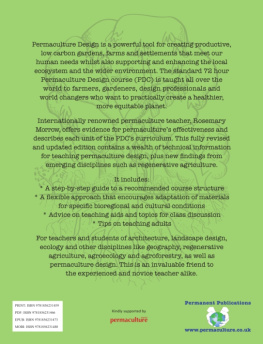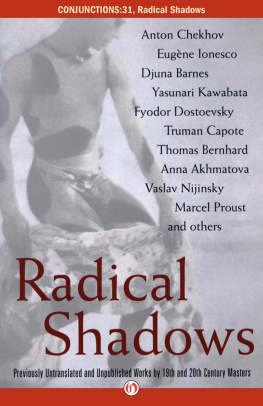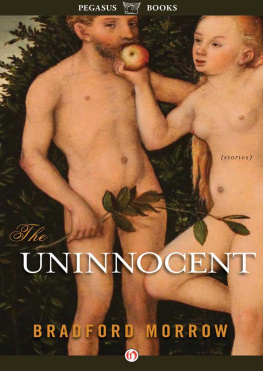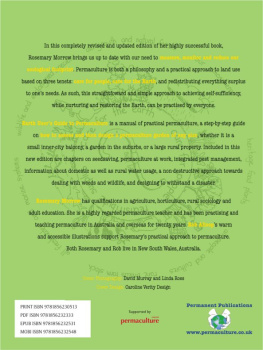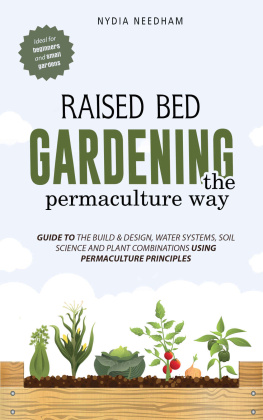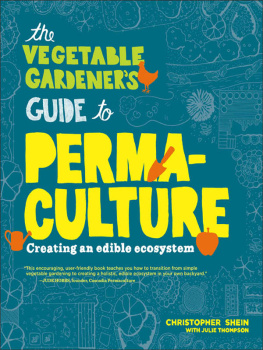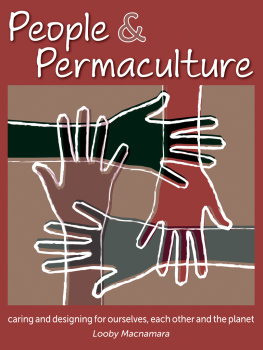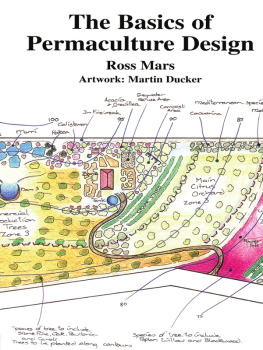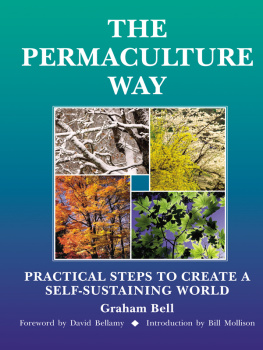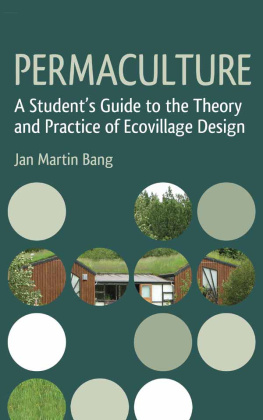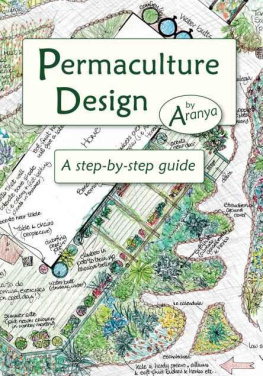earth users guide to
teaching
permaculture
Rosemary Morrow

Permanent Publications
Published by:
Permanent Publications
Hyden House Limited
The Sustainability Centre
East Meon
Hampshire
GU32 1HR
United Kingdom
Tel: 01730 823 311
Fax: 01730 823 322
Overseas: (international code +44 - 1730)
www.permanentpublications.co.uk
Print edition distributed in the USA by
Chelsea Green Publishing Company
PO Box 428, White River Junction, VT 05001
www.chelseagreen.com
First published 1997, fully revised and updated 2014
2014 Rosemary Morrow
Designed by
Two Plus George Limited
www.TwoPlusGeorge.co.uk
Cover design by
John Adams, drawings by Gabrielle Paananen
Illustrations by
Gabrielle Paananen
Index by
Amit Prasad,
British Library Cataloguing-in-Publication Data
A catalogue record for this book is available from the British Library
PRINT: ISBN 9781856231459
PDF: ISBN 9781856231466
EPUB: ISBN 9781856231473
MOBI: ISBN 9781856231480
All rights reserved. No part of this publication may be reproduced, stored in a retrieval system, rebound or transmitted in any form or by any means, electronic, mechanical, photocopying, recording or otherwise, without the prior permission of Hyden House Limited.
Contents
Section 1:
Introductions and starting well
Section 2:
Introduction to permaculture
Section 3:
Ecological themes
Section 4:
Designing productive ecosystems
Section 5:
Increasing resilience and productivity
Section 6:
Social permaculture
Dedication
I dedicate this book to my committed, funny and
passionate nephew, Michael, who made all our lives
better and lived permaculture. Michael had a
profound love of all living and non-living Earth.
His miracle was Life.
SECTION 1
Introductions and starting well
Letter to teachers
Dear permaculture teacher
In the 17 years since I wrote the first edition of this book the world has changed inconceivably, and the speed and direction of change is alarming. However the permaculture curriculum is still excellent and needs little alteration.
What students require from you
The major outcome for students is their ability to evaluate landscape and redesign it for a robust and resilient future. You need to get them to this point. Your students will mirror your knowledge, attitudes and skills when they finish their classes.
Teaching permaculture requires you to have:
- Sound unbiased knowledge, clear teaching goals, strategies and methods
- Clear understanding of the skills and attitudes students will be competent in by the end of your course
If you dont have clear teaching goals and student outcomes you wont be able to monitor their progress and your students wont be competent permaculturists.
Start by telling students that they wont be spending much time getting their hands dirty. These bootcamp skills follow the Permaculture Design Course (PDC) and will occupy them for the rest of their lives. Instead, in your course, they will learn to see, consider, analyse and design productive landscapes from balconies to large farms and towns. Permaculture uses low technology and high science, and the PDC always remains solidly based on these tangibles.
Resources and opportunities for teachers
There is often little opportunity for professional exchanges among teachers on their methods of teaching, their presentation of material and quality control of knowledge and skills. I speak of the loneliness of the Permaculture Design Teacher because many of us seldom have opportunities to see how we can improve or change our teaching to be more effective. We do not always know if we are teaching to a high standard, and how much we are in sync with other teachers. We all want to teach well to a good standard. Some of us have no teaching experience; others have some experience in teaching but have not been very long in permaculture. Most are strong in some areas yet weak in others. Some would like to teach but have not dared until now because it seemed overwhelming. I suggest that we teachers offer places for trainee teachers to learn.
This book will assist you to put together a set of teaching notes. After teaching permaculture for nearly ten years it took me another two years to assemble and order this information and it will never be finished.
You will want to develop your own notes to suit the courses that you run. The basic syllabus does not need to change. It is gift to us as teachers and to the world. My teaching style and methods change appropriately for different topics, as will yours.
Course notes have been produced by Robin Frances in Lismore, New South Wales, by Sky formerly of Crystal Waters Queensland, and by teachers in other parts of the world. I encourage you to look at them. Robin Clayfield offers courses in creative facilitation relevant to permaculture. Other teachers have put their curriculum online.
Can the PDC change?
Although the ethics and principles of the PDC remain unchanged and enduring, the structure and flow can change. I prefer to develop landscape reading and analysis skills first as design begins immediately with analysis, such as in map reading and sector analysis.
The content and teaching methods, strategies and techniques in permaculture have been corroborated as new information about the environment surfaces. The ethics and principles of permaculture stay constant, and now much of the content given in early courses has been corroborated and extended by recent research and practice. For example, zone III now has principles and examples beyond Fukuoka and alley cropping, including pasture cropping, contour forests and provides solid evidence for cell grazing and pasture cropping which was not available for the first edition of this book. New cities and city regeneration now have fine principles to assist permaculture designers.
Who can teach?
By permaculture tradition anyone who has a PDC can teach permaculture and use the word permaculture which is invested in PDC graduates. Some institutes and organisations now desire diplomas and for graduates to wait two years before teaching. I think it is better to start as quickly as possible to maintain enthusiasm, knowledge and motivation. The two year rule simply doesnt make sense for some people who arrive extraordinarily well equipped to start teaching, and for others where the national need and demands is very great. They need another pathway.
The adult learned centred approach
The difference between this book and other teachers notes is my emphasis on adult learners. I call this learner care based on Care of People and it entails teaching permaculture based on the second permaculture ethic. Being passionate about teaching adults, I use the most recent research on how adults learn and I find this approach not only ethical, but also extremely effective.
We dont teach religion or psychology, only Care of People as best exemplified by our behaviour towards students and other: Treat them well and require them to treat each other well.
The structure of these teaching notes
The choice is yours. You can work your way from the beginning to the end and you can follow my timetable (see Appendix). Or, you can draw up your own timetable and then select the units to give continuity and depth to your teaching.

